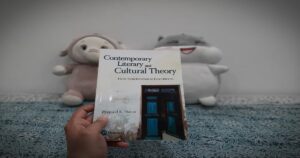6 Important Pillars of Structuralism
Structuralism is a literary theory that came into existence in the early 20th century which makes an essential part of the UGC-NET English examination. It is a small effort to help you understand it better so that you can make most out of it when needed.
Table of Contents

What is Structuralism?
It is an intellectual movement that seeks to analyze and understand the underlying structures and patterns that shape human culture, language, and consciousness. It focuses on the relationships between elements, rather than the elements themselves, to uncover the deeper structures that govern human experience.
Key Features of Structuralism:
- Focus on underlying structures: It seeks to uncover the hidden patterns and structures that shape human culture and consciousness.
- Analysis of relationships: Structuralists analyze the relationships between elements, rather than the elements themselves, to understand how they fit into larger structures.
- Search for universals: Structuralists seek to identify universal patterns and structures that apply across cultures and languages.
- Rejection of surface-level appearances: Structuralists reject the idea that surface-level appearances reveal the true nature of reality. Instead, they seek to uncover the deeper structures that underlie appearances.
Major Figures in Structuralism:
- Ferdinand de Saussure: Considered the father of modern linguistics, Saussure developed the concept of signs and signifiers, and introduced the idea of language as a system (langue) versus speech (parole) along with synchronic and dychronic studies of language.
- Claude Lévi-Strauss: An anthropologist who applied structuralism to the study of culture, Lévi-Strauss analyzed cultural myths and kinship structures to uncover underlying patterns and structures, who is also known to have developed the idea of bricolage.
- Louis Althusser: A philosopher and sociologist, Althusser developed a structuralist approach to Marxism, focusing on ideological state apparatuses and the ways in which they shape our understanding of the world. Althusser have introduced many terms such as relative autonomy, interpellation, etc.
- Roland Barthes: A literary theorist and semiotician, Barthes analyzed the structural relationships between signs and meanings in literature and culture.
- Michel Foucault: A philosopher and historian, Foucault examined the structural relationships between power, knowledge, and discourse, and developed the concept of disciplinary power, who is known to have introduced the concepts such as discursive practices that would lead to the development of New-historicism.
- Jacques Lacan: A psychoanalyst, Lacan developed a structuralist approach to psychoanalysis, focusing on the symbolic order and the ways in which it shapes our understanding of ourselves and the world. Lacan is mainly known for his mirror stage theory.

Influence of Structuralism:
Structuralism has had a profound influence on a wide range of fields, including:
- Linguistics: Structuralism revolutionized the study of language, leading to the development of modern linguistics.
- Anthropology: Structuralism transformed the study of culture, leading to a greater understanding of cultural patterns and structures.
- Philosophy: Structuralism influenced the development of continental philosophy, particularly in the areas of hermeneutics and post-structuralism.
- Literary Theory: Structuralism shaped the development of literary theory, particularly in the areas of semiotics and narratology.
- Psychoanalysis: It influenced the development of psychoanalysis, particularly in the areas of the symbolic order and the structure of the self.

Important Works Associated with Structuralism:
- Course in General Linguistics (1916) by Ferdinand de Saussure
Introduction: This book is considered the foundation of modern linguistics and structuralism. Saussure explores the underlying structures of language, challenging traditional notions of linguistics.
Important concepts: Sign and signifier, langue vs. parole, synchrony vs. diachrony, arbitrariness of the sign.
- The Elementary Structures of Kinship (1949) by Claude Lévi-Strauss
Introduction: Lévi-Strauss applies structuralism to anthropology, analyzing kinship structures and cultural myths.
Important concepts: Structural analysis, binary oppositions, kinship structures, cultural universals.
- Mythologies (1957) by Roland Barthes
Introduction: Barthes examines modern myths and cultural symbols, uncovering the underlying structures of meaning.
Important concepts: Myth, signification, cultural codes, denotation vs. connotation.
- The Death of the Author (1967) by Roland Barthes
Introduction: Barthes challenges traditional notions of authorship and meaning, arguing that the reader plays a crucial role in interpreting texts.
Important concepts: Authorship, readerly text, death of the author, intertextuality.
- The History of Sexuality (1976-1984) by Michel Foucault
Introduction: Foucault examines the structural relationships between power, knowledge, and discourse, particularly in relation to sexuality.
Important concepts: Power-knowledge nexus, disciplinary power, discourse analysis, sexuality as a social construct.
- The Four Fundamental Concepts of Psycho-Analysis (1973) by Jacques Lacan
Introduction: Lacan develops a structuralist approach to psychoanalysis, exploring the symbolic order and its role in shaping the self.
Important concepts: Symbolic order, imaginary and symbolic registers, mirror stage, lack and desire.

Some key concepts that run through these works include:
- Structural analysis: Examining underlying patterns and relationships rather than surface-level appearances.
- Binary oppositions: Analyzing pairs of opposing concepts to uncover deeper structures.
- Sign and signifier: Understanding the relationship between words, symbols, and their meanings.
- Cultural universals: Identifying common patterns and structures across cultures.
- Power-knowledge nexus: Examining how power and knowledge intersect and shape our understanding of the world.
These works and concepts represent some of the core ideas and contributions of structuralism, which has had a profound impact on various fields of study.
You can also read about the important books to start preparing for the upcoming exam at UGC-NET English: 4 Amazing Books to Read







One thought on “6 Important Pillars of Structuralism”